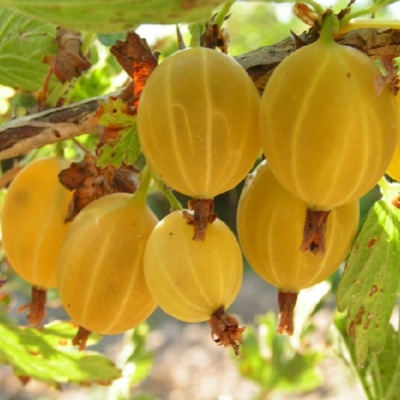
- Authors: Latvia
- Name synonyms: Grossularia Kuršu Dzintars
- Growth type: medium-sized
- Description of the bush: compact, medium spreading
- Escapes: straight, thin, massive, graceful, stretching to the sky and in different directions
- Thorniness: medium
- Thorns: located more often one at a time, low, very sharp, brown
- Sheet: bright light green, with slight yellowness at the base, medium size
- Berry size: small
- Berry weight, g: 2,7
The cold-resistant gooseberry Kursu Dzintars was bred by Latvian breeders and tolerates difficult climatic conditions. The berries are distinguished by excellent marketability and transportability, and are suitable for sale. It is also known as Grossularia Kuršu Dzintars.
Description of the variety
Gooseberries of this variety form bushes of medium height up to 150 cm in a compact format. The crown is medium spreading, with straight thin shoots, bright light green leaves, slightly yellowish at the base. Branches are covered with single brown thorns, sharp, of small height.
Characteristics of berries
Curšu Dzintars bears fruit with small berries of a beautiful amber-yellow hue when ripe. The veins are clearly visible on the skin, it is thin and shiny. The shape of the fruit is oval, regular. The average berry weight is 2.7 g.
Taste qualities
The berries are sweet, very juicy. The taste is assessed as dessert. There is a light characteristic aroma.
Ripening and fruiting
The variety is partially self-fertile (up to 20% of flowers), to increase productivity, it is recommended to plant a number of pollinators with the same flowering period - from the 2nd decade of May. Gooseberry Kursu Dzintars ripens early, together. Fruiting occurs in late July - early August.
Yield
4-6 kg of berries are harvested from 1 bush per season.
Growing regions
The variety is suitable for planting in the climate of the North-West region, in the Far East, in Central Russia. There is experience of its cultivation in the conditions of the Urals and Siberia.
Landing
Plants are not too demanding in choosing a place for planting. They can be placed in the sun and partial shade. The soil is preferable loamy or light chernozem. It is important that the soil is breathable, loose enough, moderately moist. Dense soils are diluted with sand, peat, humus. It is better to plant in autumn, September or early October, but no later than 2 weeks before the start of the frost period.
To protect against the through wind, gooseberries are often placed in a shelter in the form of fences, walls of buildings and structures, gabions. It is necessary to retreat from such objects at least 1 m, it is customary to leave at least 1.5 m between the bushes themselves. Lowlands, areas with a high groundwater level will not work. The soil must be pretreated from weeds, or covered with agrofibre, film, impervious to light.
The pit is formed so that its diameter is twice the size of the root system. If the soil is not fertile enough, it is taken out, mineral fertilizers are added. The roots of the seedling are freed from excess soil, set on a mound previously poured in the center of the hole. The root collar is not deepened in this variety. Watering after planting is carried out with 2 full buckets of water, with gradual application.

Growing and caring
The basic rules for caring for plants of the Kursu Dzintars variety are reduced to maintaining the compact shape of the bush. Its crown is prone to thickening, needs periodic dilution. It is important that shoots of different ages are present on the plant. Young branches are left annually in the amount of 5-6 pieces. Pruning old and dry leaves is carried out to the base.
Even during periods of drought, this gooseberry variety requires a moderate amount of moisture. Sprinkling performed in the morning or evening hours will be useful. Fertilizing the bushes is also necessary without excessive zeal. If fertilizing was laid in the hole during planting, they will not have to be added for the next 2 years. Then, according to the schedule, in the spring, nitrogen substances are fed under the root - rotted manure or urea, and in the summer - potassium and phosphorus.
Young shrubs require a garter. This will direct the growing shoots vertically. In the fall, the mating is weakened, in the root zone the soil is intensively hilled. In the early years, gooseberries are covered with spruce branches or non-woven cloth, burlap for the winter, and when snow appears, they are thrown into them for warming.



Disease and pest resistance
The cultivar shows medium resistance to anthracnose, American powdery mildew. For rust, septoria, plants are recommended to be regularly treated with solutions of copper sulfate or Bordeaux liquid in a minimum concentration. Among the pests for this variety, the most dangerous are shoot aphids, moth butterflies and scale insects, sawflies. You can reduce the risks of infection by carefully removing fallen leaves, performing periodic spraying with complex insecticides.

In order for the gooseberry to produce a good harvest, it is necessary to devote time to disease prevention.
Resistance to adverse climatic conditions
The gooseberry of this variety is very winter-hardy, it successfully tolerates a significant drop in atmospheric temperatures. Included in the list of plants of 4 climatic zones. Does not require shelter in frosts down to -32 degrees. Able to tolerate short term droughts.




































































